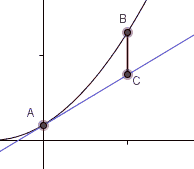I will soon have to teach Taylor's formulas (with Lagrange and Peano¹ remainder terms) to first-year students in math-related curricula (computer science, physics, engineering), and I am not terribly satisfied with the proofs I have seen. I do not care so much about having optimal hypotheses, so I am happy to derive Taylor-Peano for $C^k$ functions from Taylor-Lagrange. But the only proof I have found (in numerous places) of Taylor-Lagrange looks like a clever trick: one introduce the number $A$ such that the function defined from $f$ by $$g(x) := f(b)-\Big(f(x) + (b-x) f'(x) + \dots + (b-x)^k \frac{f^{(k)}}{k!} +(b-x)^{k+1} \frac A{(k+1)!}\Big)$$ satisfies $g(a)=0$, and then applies Rolle' theorem to $g$.
Do you know of a proof that carries more intuition about why the result is true? Alternatively, how would you explain the intuition, if any, behind this proof?
What bothers me is that the mean value theorem is deduced from Rolle's theorem in a very clear way; maybe this is linked with the statement itself being more intuitively explained.
Added in edit 1. Let me clarify what bothers me here: the mean value theorem is pretty clear in its statement, as it basically says that a car that drove 60 miles in 2 hours must have had instant speed 30 mph at some point. Moreover a simple drawing explains both the statement and the proof. Somehow, I feel there should be some sort of equivalent explanations, only slightly more involved, for the Taylor-Lagrange formula and its proof. An example of what bothers me is that I found no proof that explicitly involved acceleration for the $k=1$ case.
Added in edit 2. Let me precise the background of my students: they are assumed to have the background of French scientific section of high school, plus one semester course on reals, sequences and functions (including derivatives, Rolle's theorem and the mean value theorem). My goal would be to show them proofs that they feel they could have discovered, if given time to think about them.
Too many proofs look (to students) like aliens gave them to us; this can be either because we choose to teach shorter but less conceptual proofs, or because they where discovered after long and hard thinking by mathematicians with much more training and experience and intuition than they currently have. Independently of why it is so, I think this matter of fact tends to reinforce their common belief that math is a collection of magical formulas that have no true meaning and can only be learned by heart (and beware what happens if you use the wrong formula!)
¹ This is called after Young in France.
